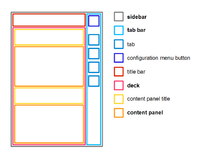Sidebar
The sidebar is a new feature in the 4.0 release. It combines ideas and code from both the Symphony sidebar and the OpenOffice Impress task pane.
The UX part of the work is described on another page. This page focuses on the API design and implementation.
Help in every form is welcome. After reading the general introductory stuff:
- if you are a developer and want to implement a new panel then go to Sidebar for Developers
- if you are interested in QA then proceed to section QA
Contents
Glossary
Work in progress. Comments are welcome.
- sidebar
- Name of the feature and name of the control including all its components (icon bar, content panels).
- Also known as task pane(l) or tool pane(l)
- tab bar
- Similar to a vertical tool bar. Clicking on buttons switches between sidebar decks.
- deck
- Contains one or more content panels. Only one deck is visible at any one time.
- content panel
- Displays information about the document and/or provides the means for document modification.
- Each content panel focuses on one topic like font, table or shape properties.
- There may be more than one content panel in a deck.
- Examples are the task panels of the Impress task pane or the property views of the Symphony sidebar.
- title bar
- Displays the title for the current sidebar deck.
- Can contain a closer button.
- content panel title
- Displays the title for one content panel. Optional when there is only one content panel.
- configuration menu button
- Opens a popup menu that allows switching between decks and also allows the activation and deactivation (tab is not shown) of decks.
Panels and Decks
At any one time there is one and only one deck visible. It contains one or more panels. There are rare occasions where there is no panel for a given context, but in this case a replacement panel is displayed with a message to the effect "intentionally left blank".
The set of decks available via the tab bar and panels inside a deck depend on the current context. Contexts are defined by different features or states. This can be the selection of shapes, text editing on/off, switching between views (in Impress).
Decks
- Properties
- This deck is visible by default. Context changes typically change the set of property panels inside this deck.
- Master Pages
- This Impress only deck contains three panels for the currently used, recently used and available master pages.
- Custon Animation
- Displayed only for Impress, this deck contains only one panel for displaying and modifying shape animations.
- Slide Transition
- Another Impress only deck. It contains one panel for slide transitions.
Panels
- Text
- Text properties.
- Page
- Page properties.
- Area
- Fill style properties for shapes.
- Line
- Border style properties for shapes
- Position and Size
- Position and size for shapes.
- Graphic
- Properties for images.
- Layouts
- Impress layouts.
- Used in This Presentation
- Master pages that are in use by the current Impress document.
- Recently Used
- Master pages that where recently used by the current Impress document.
- Available for Use
- All available master pages. Independent of the current Impress document.
- Custom Animation
- Shape animations.
- Slide Transition
- Slide transitions.
- Table Design
- Table properties for Impress documents.
- Alignment
- TBD.
- Cell Appearance
- TBD.
- Number Format
- TBD.
- Paragraph
- TBD.
- Wrap
- TBD.
